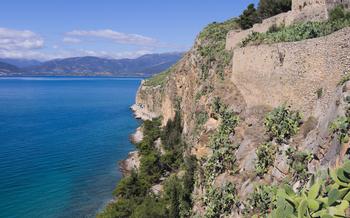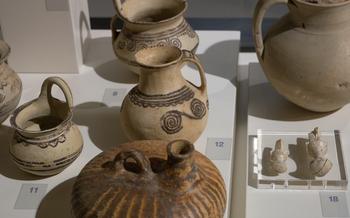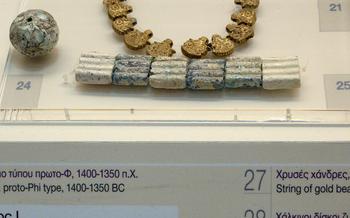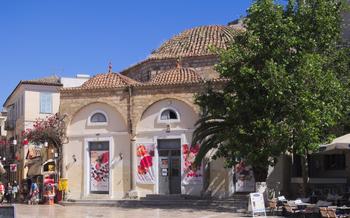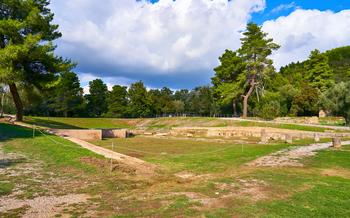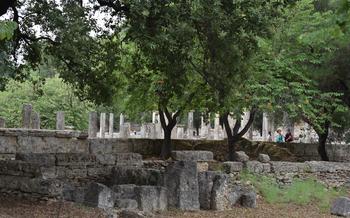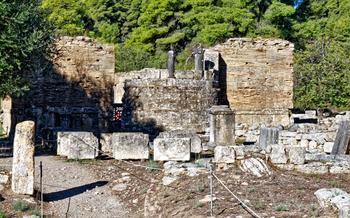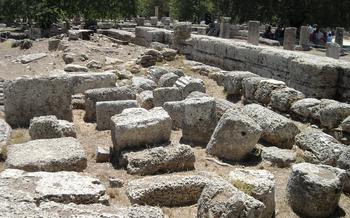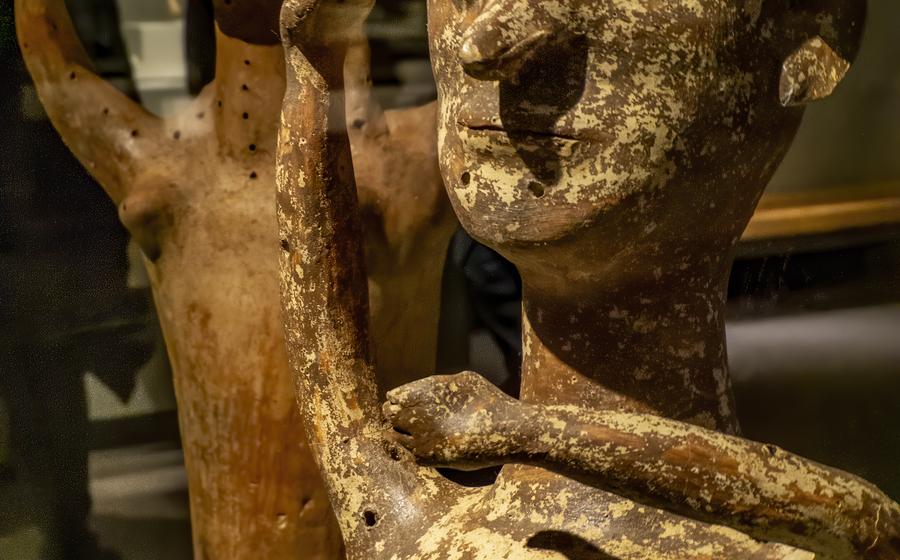
Mycenae Archaeological Site
- The Mycenae Archaeological Site: A Journey Through Ancient History
- Exploring the Lion Gate: A Majestic Entrance to Mycenae
- Unveiling the Treasury of Atreus: A Royal Tomb of Splendor
- Marveling at the Cyclopean Walls: A Testament to Ancient Engineering
- Discovering the Palace of Agamemnon: A Center of Mycenaean Power
- Exploring the Grave Circle A: Unveiling the Secrets of the Mycenaean Elite
- Witnessing the Lionesses Relief: A Symbol of Strength and Power
- Uncovering the House of the Sphinxes: A Royal Residence with Artistic Treasures
- Admire the Ramp House: A Gateway to the Acropolis
- Experience the Archaeological Museum of Mycenae
- Take a Guided Tour for an In-depth Experience
- Capture Stunning Photos for Memories
- Enjoy a Picnic Amidst History
- Wear Comfortable Shoes for the Uneven Terrain
- Insider Tip: Explore the Surrounding Area
The Mycenae Archaeological Site: A Journey Through Ancient History
Journey back in time to the Bronze Age and discover the fascinating Mycenae Archaeological Site, a testament to the power and glory of one of Greece's most prominent ancient city-states. Immerse yourself in the captivating world of Mycenaean civilization, where myths and legends intertwine with archaeological wonders, revealing a rich tapestry of history and culture.
As you step into the site, you'll be transported to a time when Mycenae stood as a powerful kingdom, dominating the Peloponnese region. Its strategic location atop a hill, overlooking the fertile Argolid Plain, speaks volumes about its strategic importance in controlling trade routes and defending against potential enemies.
Prepare to be awestruck by the iconic Lion Gate, the grand entrance to the citadel, featuring two majestic lions carved in relief, symbolizing strength and protection. Marvel at the Treasury of Atreus, a magnificent beehive-shaped tomb with its impressive corbelled arch construction, a testament to the engineering prowess of the Mycenaeans.
Explore the awe-inspiring Cyclopean Walls, built using massive stone blocks without the use of mortar, showcasing the architectural ingenuity of this ancient civilization. These walls once served as a formidable defense system, protecting the city from invaders and contributing to its legendary invincibility.
Exploring the Lion Gate: A Majestic Entrance to Mycenae
The Lion Gate, an iconic landmark of Mycenae, stands as a testament to the city's architectural prowess and cultural significance. Carved from a single block of limestone, this imposing gateway features two majestic lions in relief, symbolizing strength, power, and protection. The lintel stone above the gate, weighing an estimated 20 tons, further adds to the awe-inspiring presence of the structure.
The lions, depicted in a heraldic pose with their heads turned outward, are believed to represent the goddess Artemis, who was worshipped as the protector of Mycenae. Their fierce expressions and muscular bodies convey a sense of power and authority, befitting the entrance to a mighty city-state.
The construction techniques employed in creating the Lion Gate demonstrate the advanced engineering skills of the Mycenaeans. The massive stone blocks were carefully quarried, transported, and precisely fitted together without the use of mortar. This remarkable feat of engineering has stood the test of time, with the gate remaining largely intact despite its age.
As the main entrance to the city, the Lion Gate held strategic importance. It provided a fortified passageway, allowing for controlled access and defense against potential invaders. The gate's imposing presence served as a symbol of Mycenae's power and military prowess, deterring enemies from attempting to breach the city's defenses.
Unveiling the Treasury of Atreus: A Royal Tomb of Splendor
The Treasury of Atreus, also known as the Tomb of Agamemnon, stands as a testament to the architectural prowess and royal opulence of the Mycenaean civilization. This awe-inspiring beehive-shaped tholos tomb is a marvel of ancient engineering, constructed using the corbelled arch technique, where each layer of stone is slightly cantilevered over the one below, creating a self-supporting dome.
As you step inside the tomb, you'll be struck by its sheer size and grandeur. The domed chamber, measuring over 14 meters in height and 13 meters in diameter, exudes an atmosphere of majesty and reverence. The walls are adorned with intricate stone reliefs, hinting at the wealth and power of the Mycenaean rulers who were laid to rest within.
Excavations of the Treasury of Atreus have yielded a treasure-trove of artifacts, including gold jewelry, pottery, and weapons, which provide valuable insights into the lavish burial practices of the Mycenaean elite. These discoveries have shed light on the opulence and sophistication of Mycenaean culture, showcasing their mastery of craftsmanship and their obsession with the afterlife.
The Treasury of Atreus serves as a powerful reminder of the grandeur and artistry of the Mycenaean civilization. As you explore its depths, you'll be transported back in time, experiencing the splendor and opulence of a long-lost era.
Marveling at the Cyclopean Walls: A Testament to Ancient Engineering
The Cyclopean Walls of Mycenae stand as a testament to the remarkable engineering prowess of the ancient Mycenaeans. Constructed using massive stone blocks, some weighing up to several tons, the walls were built without the use of mortar or any binding agents. The sheer size and weight of the blocks, coupled with the intricate construction techniques employed, have left historians and archaeologists in awe.
The walls, which encompass the entirety of the citadel, served as a formidable defense system for the city. Their height and thickness made them virtually impenetrable, protecting Mycenae from potential invaders and securing its position as a powerful city-state during the Bronze Age. The walls also played a crucial role in controlling access to the city, with a series of gates strategically positioned along their length.
One of the most intriguing aspects of the Cyclopean Walls is the legend associated with their construction. According to Greek mythology, the walls were built by the Cyclopes, a race of one-eyed giants. The Cyclopes, who were renowned for their strength and craftsmanship, were said to have been commissioned by King Eurystheus to construct the walls as a punishment for Hercules.
While the legend of the Cyclopes adds an element of myth and mystery to the Cyclopean Walls, it is clear that their construction was a remarkable feat of engineering. The walls' enduring strength and resilience, despite centuries of weathering and the passage of time, stand as a testament to the ingenuity and skill of the ancient Mycenaeans.
Discovering the Palace of Agamemnon: A Center of Mycenaean Power
The Palace of Agamemnon, located within the citadel of Mycenae, stands as a testament to the grandeur and power of Mycenaean civilization. This impressive structure, believed to have been the residence of the legendary king Agamemnon, offers a glimpse into the sophisticated lifestyle and administrative prowess of the Mycenaean elite.
The palace is centered around a grand megaron, a large rectangular hall characterized by its central hearth and supported by wooden columns. This impressive space served as the main gathering area for the king and his court, where important decisions were made, and guests were entertained. The megaron's walls were adorned with vibrant frescoes, depicting scenes from Mycenaean life and mythology, adding to the opulent atmosphere of the palace.
Beyond the megaron, the palace complex encompasses a variety of other rooms, including storage areas, workshops, and living quarters. These spaces provide insights into the daily lives of the Mycenaean rulers and their entourage. Artifacts uncovered during excavations, such as pottery, tools, and jewelry, shed light on the economic activities, technological advancements, and artistic achievements of the Mycenaean civilization.
The Palace of Agamemnon serves as a tangible reminder of the sophisticated urban centers that flourished during the Bronze Age in Greece. Its grand architecture, intricate artwork, and strategic location speak to the power and influence of the Mycenaean rulers, who presided over a prosperous and vibrant civilization.
Exploring the Grave Circle A: Unveiling the Secrets of the Mycenaean Elite
Nestled outside the walls of Mycenae lies Grave Circle A, a captivating burial ground that once held the remains of Mycenae's rulers and their families. As you approach the site, the grandeur of these ancient tombs becomes evident. Each tomb is a testament to the power and prestige of the Mycenaean elite, showcasing their wealth and status through elaborate grave goods.
Excavations of Grave Circle A have yielded a treasure trove of artifacts, providing valuable insights into Mycenaean burial practices and social structure. Within the tombs, archaeologists have discovered an array of gold jewelry, intricately decorated pottery, bronze weapons, and other precious objects, all carefully placed to accompany the deceased on their journey to the afterlife.
The most striking feature of Grave Circle A is the unique construction of the shaft graves. These deep, rectangular pits were carefully carved into the bedrock, with stone slabs lining the sides and a corbelled roof overhead. The sheer size and complexity of these graves attest to the engineering prowess of the Mycenaeans and their dedication to honoring their departed leaders.
By exploring Grave Circle A, visitors can gain a deeper understanding of the Mycenaean civilization's beliefs and customs surrounding death and the afterlife. These tombs offer a glimpse into the lives of the elite, showcasing their wealth, power, and the intricate social hierarchy that existed within Mycenaean society.
Witnessing the Lionesses Relief: A Symbol of Strength and Power
Amidst the grandeur of Mycenae, the Lionesses Relief stands as a testament to the city's artistic prowess and cultural identity. Carved above the iconic Lion Gate, this intricate masterpiece depicts two majestic lionesses flanking a central column, their fierce gaze symbolizing strength, protection, and royalty. The lionesses, believed to be associated with the goddess Artemis, were revered in Mycenaean culture as symbols of power and ferocity.
The relief's strategic placement above the main entrance to the city further emphasizes its significance. As visitors passed through the Lion Gate, they were greeted by this powerful image, reminding them of the strength and authority of Mycenae. The Lionesses Relief served as a visual representation of the city's resilience and its ability to ward off enemies.
This remarkable artwork offers a glimpse into the artistic achievements of Mycenaean civilization. The intricate details and lifelike portrayal of the lionesses showcase the skill and craftsmanship of the Mycenaean artisans. The relief's enduring presence, despite the passage of time and the ravages of history, speaks to the enduring legacy of Mycenaean culture and its profound impact on the development of Western civilization.
Uncovering the House of the Sphinxes: A Royal Residence with Artistic Treasures
Among the remarkable structures within the Mycenae Archaeological Site, the House of the Sphinxes stands out as a testament to Mycenaean artistry and opulence. This grand residence, believed to have belonged to high-ranking officials or members of the royal family, boasts an impressive megaron, a large rectangular hall characteristic of Mycenaean architecture. The megaron's walls are adorned with intricate frescoes depicting majestic sphinxes, mythical creatures with the body of a lion and the head of a human. These frescoes, remarkably well-preserved despite the passage of time, offer a glimpse into the artistic prowess and symbolism of Mycenaean culture.
Excavations at the House of the Sphinxes have yielded a wealth of artifacts and treasures, shedding light on the daily life and customs of the Mycenaean elite. Among the discoveries are finely crafted pottery, bronze tools, and jewelry, all showcasing the exceptional craftsmanship of the Mycenaean artisans. The house's well-preserved remains, including sections of its walls, columns, and staircases, provide further insights into the architectural techniques and domestic arrangements of this ancient civilization.
The House of the Sphinxes stands as a symbol of Mycenae's artistic and cultural achievements, offering visitors a glimpse into the lives of the city's powerful rulers and their entourage. Its enduring legacy serves as a reminder of the sophistication and complexity of Mycenaean civilization, which played a pivotal role in shaping the course of ancient Greek history.
Admire the Ramp House: A Gateway to the Acropolis
Strategic Location
The Ramp House holds a strategic position at the entrance to the acropolis, serving as a gateway to the citadel. This placement allowed for controlled access to the fortified upper city, ensuring the security and defense of Mycenae. The ramp leading up to the house further enhanced its defensive capabilities, acting as a natural barrier against potential intruders.
Architectural Features
The Ramp House is a testament to the advanced architectural skills of the Mycenaeans. The impressive ramp, constructed with large stone blocks, leads visitors up to the house, providing a grand entrance to the acropolis. The well-preserved remains of the structure, including walls, doorways, and foundations, offer a glimpse into the architectural prowess of this ancient civilization.
Historical Significance
The Ramp House stands as a symbol of Mycenae's military prowess and strategic importance. Its commanding position at the entrance to the acropolis highlights the city's preparedness for defense and its ability to withstand attacks. The ramp, with its steep incline, served as a formidable obstacle for potential invaders, making it challenging to breach the city's defenses.
Anecdote: The Trojan Horse and the Ramp House
The Ramp House is closely associated with the legendary Trojan Horse, a tale that has captured the imagination of generations. According to Greek mythology, the Greeks used a giant wooden horse as a ruse to infiltrate the city of Troy. Some variations of the myth suggest that the horse was brought into the city through the Ramp House, highlighting its significance as an entry point to Mycenae.
Experience the Archaeological Museum of Mycenae
To delve deeper into the captivating history of Mycenae, a visit to the Archaeological Museum of Mycenae is a must. This treasure trove of artifacts and relics offers a remarkable glimpse into the lives and culture of the ancient Mycenaeans. Among the highlights of the collection are exquisite gold jewelry, intricately painted pottery, and formidable weapons, all unearthed from the archaeological site. These artifacts provide tangible evidence of the opulence, artistry, and military prowess of this once-mighty civilization.
The museum's well-curated exhibits are designed to educate and inspire visitors, providing historical context and insights into the significance of each artifact. Through interactive displays and informative panels, visitors can learn about the rise and fall of Mycenae, its social structure, religious beliefs, and trading networks. The museum also offers guided tours led by knowledgeable experts who can provide in-depth explanations and answer any questions visitors may have.
A visit to the Archaeological Museum of Mycenae is an ideal way to complement the exploration of the archaeological site itself. By combining the two experiences, visitors can gain a comprehensive understanding of Mycenaean civilization and its enduring legacy. Remember to allow ample time to fully appreciate the museum's collection and immerse yourself in the fascinating world of ancient Greece.
Take a Guided Tour for an In-depth Experience
Embark on a guided tour to enhance your visit to the Mycenae Archaeological Site. Led by knowledgeable experts, these tours offer a wealth of insights into the site's history, culture, and significance. Learn about the latest archaeological discoveries, unravel the mysteries of Mycenaean civilization, and have your questions answered by experienced professionals. Choose from various tour options, including group tours for a social experience or private tours for a more personalized exploration. To avoid disappointment and secure your spot, especially during peak season, book your guided tour in advance.
Capture Stunning Photos for Memories
The Mycenae Archaeological Site offers a wealth of captivating photo opportunities, allowing visitors to capture the essence of this ancient civilization. The iconic landmarks, such as the Lion Gate and the Treasury of Atreus, stand as majestic subjects, inviting photographers to capture their grandeur. The surrounding landscape, with its rolling hills and picturesque vistas, provides a stunning backdrop for panoramic shots. For the most captivating lighting conditions, plan your visit during the golden hour, around sunrise or sunset, when the warm hues bathe the ruins in a magical glow. Whether you're a seasoned photographer or simply seeking to preserve your memories, Mycenae offers an abundance of opportunities to capture stunning images that will transport you back in time.
Enjoy a Picnic Amidst History
Enhance your visit to the Mycenae Archaeological Site by packing a delightful picnic to savor amidst the ancient ruins. Designated picnic areas within the site invite you to take a break, relax, and enjoy a leisurely meal surrounded by history. Spread out your blanket beneath the shade of olive trees and soak in the ambiance of this remarkable place. Indulge in local delicacies, fresh fruits, and refreshing beverages while immersing yourself in the spirit of ancient Greece. Remember to bring your own snacks and drinks, as food options on-site are limited. This delightful picnic experience will create lasting memories as you dine in the company of history at the Mycenae Archaeological Site.
Wear Comfortable Shoes for the Uneven Terrain
Exploring the Mycenae Archaeological Site involves navigating uneven and rocky terrain. Sturdy and comfortable shoes are essential to ensure a safe and enjoyable experience. Avoid sandals or flip-flops, as they may not provide adequate support and protection for your feet. Consider wearing hiking boots or sneakers with good traction to navigate the uneven surfaces and rocky paths with ease. This will allow you to fully immerse yourself in the ancient history of Mycenae without having to worry about discomfort or injury.
Insider Tip: Explore the Surrounding Area
Mycenae's rich historical significance extends beyond its own boundaries. The region surrounding Mycenae is dotted with other ancient sites that offer a glimpse into the broader context of Greek history and culture.
Tiryns, located just a short drive from Mycenae, boasts impressiveCyclopean walls that rival those of Mycenae. The well-preserved ruins of the palace and the lower town provide a fascinating glimpse into the life of another powerful Mycenaean city-state.
Epidaurus, renowned for its ancient theater, is another must-visit destination. The remarkably intact theater, built in the 4th century BC, is considered one of the finest examples of ancient Greek architecture and acoustics.
To make the most of your trip and explore these nearby attractions conveniently, consider renting a car or joining a guided tour that includes visits to multiple sites in the region. This will allow you to delve deeper into the history and culture of ancient Greece and create a truly memorable experience.
